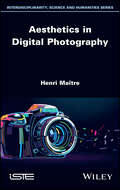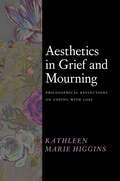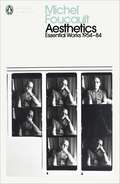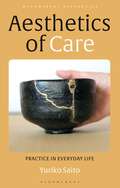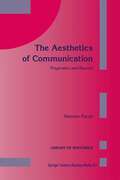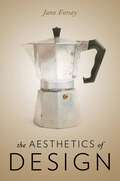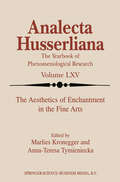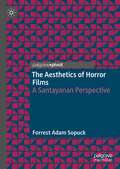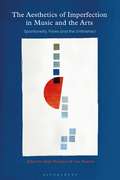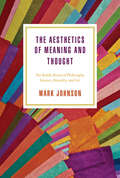- Table View
- List View
Aesthetics in Digital Photography
by Henri MaîtreAutomatically evaluating the aesthetic qualities of a photograph is a current challenge for artificial intelligence technologies, yet it is also an opportunity to open up new economic and social possibilities.Aesthetics in Digital Photography presents theories developed over the last 25 centuries by philosophers and art critics, who have sometimes been governed by the objectivity of perception, and other times, of course, by the subjectivity of human judgement. It explores the advances that have been made in neuro-aesthetics and their current limitations.In the field of photography, this book puts aesthetic hypotheses up against experimental verification, and then critically examines attempts to “scientifically” measure this beauty. Special attention is paid to artificial intelligence techniques, taking advantage of machine learning methods and large databases.
Aesthetics in Grief and Mourning: Philosophical Reflections on Coping with Loss
by Kathleen Marie HigginsA philosophical exploration of aesthetic experience during bereavement. In Aesthetics of Grief and Mourning, philosopher Kathleen Marie Higgins reflects on the ways that aesthetics aids people experiencing loss. Some practices related to bereavement, such as funerals, are scripted, but many others are recursive, improvisational, mundane—telling stories, listening to music, and reflecting on art or literature. Higgins shows how these grounding, aesthetic practices can ease the disorienting effects of loss, shedding new light on the importance of aesthetics for personal and communal flourishing.
Aesthetics in Grief and Mourning: Philosophical Reflections on Coping with Loss
by Kathleen Marie HigginsA philosophical exploration of aesthetic experience during bereavement. In Aesthetics of Grief and Mourning, philosopher Kathleen Marie Higgins reflects on the ways that aesthetics aids people experiencing loss. Some practices related to bereavement, such as funerals, are scripted, but many others are recursive, improvisational, mundane—telling stories, listening to music, and reflecting on art or literature. Higgins shows how these grounding, aesthetic practices can ease the disorienting effects of loss, shedding new light on the importance of aesthetics for personal and communal flourishing.
Aesthetics: The Key Thinkers (Key Thinkers)
by Alessandro GiovannelliAesthetics: The Key Thinkers offers a comprehensive historical overview of the field of aesthetics. Thirty specially commissioned essays introduce and explore the contributions of philosophers who have shaped the subject, from its origins in the work of the ancient Greeks to contemporary developments in the 21st century. Now thoroughly revised and updated throughout, this second edition includes new chapters on Ludwig Wittgenstein, Susanne Langer, Bernard Bolzano, as well as more coverage of post-1950 aesthetics with Frank Sibley, Stanley Cavell, Peter Kivy, Noël Carroll, Peter Lamarque, and Jerrold Levinson. The book reconstructs the history of aesthetics, clearly illustrating the most important attempts to address such crucial issues as the nature of aesthetic judgment, the status of art, and the place of the arts within society. Ideal for undergraduate students, it lays the necessary foundations for a complete and thorough understanding of this fascinating subject.
Aesthetics: The Key Thinkers (Key Thinkers)
Aesthetics: The Key Thinkers offers a comprehensive historical overview of the field of aesthetics. Thirty specially commissioned essays introduce and explore the contributions of philosophers who have shaped the subject, from its origins in the work of the ancient Greeks to contemporary developments in the 21st century. Now thoroughly revised and updated throughout, this second edition includes new chapters on Ludwig Wittgenstein, Susanne Langer, Bernard Bolzano, as well as more coverage of post-1950 aesthetics with Frank Sibley, Stanley Cavell, Peter Kivy, Noël Carroll, Peter Lamarque, and Jerrold Levinson. The book reconstructs the history of aesthetics, clearly illustrating the most important attempts to address such crucial issues as the nature of aesthetic judgment, the status of art, and the place of the arts within society. Ideal for undergraduate students, it lays the necessary foundations for a complete and thorough understanding of this fascinating subject.
Aesthetics, Method, and Epistemology: Essential Works of Foucault 1954-1984
by Michel Foucault'A magnificent, essential compendium, in the absence of which the man, the thinker and his thought would have been amputated, unfinished and incompletely understood' LiberationAesthetics offers a focused study on the philosophy, literature and other works of the imagination which have informed Foucault's particular engagement with ethics and power and includes Foucault's arresting commentaries on the work of de Sade, Rousseau, Marx, Nietzsche, Roussel and Boulez.
The Aesthetics of Argument
by Martin WarnerArgument and imagination are often interdependent. The Aesthetics of Argument is concerned with how this relationship may bear on argument's concern with truth, not just persuasion, and with the enhancement of understanding such interdependence may bring. The rationality of argument, conceived as the advancement of reasons for or against a claim, is not simply a matter of deductive validity. Whether arguments are relevant, have force, or look foolish—or whether an example is telling or merely illustrative—cannot always be assessed in these terms. Martin Warner presents a series of case studies which explore how analogy, metaphor, narrative, image, and symbol can be used in different ways to frame one domain in terms of another, severally or in various combinations, and how criteria drawn from the study of imaginative literature may have a bearing on their truth-aptness. Such framing can be particularly effective in argumentative roles which invite self-interrogation, as Plato saw long ago. Narrative in such cases may be fictional, whether parabolic or dramatic, autobiographical or biographical, and in certain cases may seek to show how standard conceptualizations are inadequate. Beyond this, whether in poetry or prose and not only with respect to narrative, the "logic" of imagery enables us to make principled sense of our capacity to grasp imagistically elements of our experience through words whose use at the imaginative level has transformed their standard conceptual relationships, and hence judge the credibility of associated arguments. Assessment of the argumentative imagination requires criteria drawn not only from dialectic and rhetoric, but also from poetics.
The Aesthetics of Argument
by Martin WarnerArgument and imagination are often interdependent. The Aesthetics of Argument is concerned with how this relationship may bear on argument's concern with truth, not just persuasion, and with the enhancement of understanding such interdependence may bring. The rationality of argument, conceived as the advancement of reasons for or against a claim, is not simply a matter of deductive validity. Whether arguments are relevant, have force, or look foolish—or whether an example is telling or merely illustrative—cannot always be assessed in these terms. Martin Warner presents a series of case studies which explore how analogy, metaphor, narrative, image, and symbol can be used in different ways to frame one domain in terms of another, severally or in various combinations, and how criteria drawn from the study of imaginative literature may have a bearing on their truth-aptness. Such framing can be particularly effective in argumentative roles which invite self-interrogation, as Plato saw long ago. Narrative in such cases may be fictional, whether parabolic or dramatic, autobiographical or biographical, and in certain cases may seek to show how standard conceptualizations are inadequate. Beyond this, whether in poetry or prose and not only with respect to narrative, the "logic" of imagery enables us to make principled sense of our capacity to grasp imagistically elements of our experience through words whose use at the imaginative level has transformed their standard conceptual relationships, and hence judge the credibility of associated arguments. Assessment of the argumentative imagination requires criteria drawn not only from dialectic and rhetoric, but also from poetics.
Aesthetics of Care: Practice in Everyday Life (Bloomsbury Aesthetics)
by Yuriko SaitoBuilding upon her previous work on everyday aesthetics, Yuriko Saito argues in this book that the aesthetic and ethical concerns are intimately connected in our everyday life. Specifically, she shows how aesthetic experience embodies a care relationship with the world and how the ethical relationship with others, whether humans, non-human creatures, environments, or artifacts, is guided by aesthetic sensibility and manifested through aesthetic means. Weaving together insights gained from philosophy, art, design, and medicine, as well as artistic and cultural practices of Japan, she illuminates the aesthetic dimensions of various forms of care in our management of everyday life. Emphasis is placed on the experience of interacting with others including objects, a departure from the prevailing mode of aesthetic inquiry that is oriented toward judgment-making from a spectator's point of view. Saito shows that when everyday activities, ranging from having a conversation and performing a care act to engaging in self-care and mending an object, are ethically grounded and aesthetically informed and guided, our experiences lead to a good life.
Aesthetics of Care: Practice in Everyday Life (Bloomsbury Aesthetics)
by Yuriko SaitoBuilding upon her previous work on everyday aesthetics, Yuriko Saito argues in this book that the aesthetic and ethical concerns are intimately connected in our everyday life. Specifically, she shows how aesthetic experience embodies a care relationship with the world and how the ethical relationship with others, whether humans, non-human creatures, environments, or artifacts, is guided by aesthetic sensibility and manifested through aesthetic means. Weaving together insights gained from philosophy, art, design, and medicine, as well as artistic and cultural practices of Japan, she illuminates the aesthetic dimensions of various forms of care in our management of everyday life. Emphasis is placed on the experience of interacting with others including objects, a departure from the prevailing mode of aesthetic inquiry that is oriented toward judgment-making from a spectator's point of view. Saito shows that when everyday activities, ranging from having a conversation and performing a care act to engaging in self-care and mending an object, are ethically grounded and aesthetically informed and guided, our experiences lead to a good life.
The Aesthetics of Communication: Pragmatics and Beyond (Library of Rhetorics #2)
by H. ParretAESTHETICIZING PRAGMATICS The Gamut of Pragmatics Pragmatics emerged among the sciences of language at the end of the 1960's in reaction to certain totalizing models in linguistics: structuralism (primarily in Europe) and generative grammar (initially in the United States). Certain disciples of Chomsky became dissatisfied with autono mous syntax and later with generative semantics: they decided to break away from their mentor. Whereas Chomsky continued to talk a lot about very little, they defied him by speaking very suggestively about an exces sively broad range of phenomena. Pragmatics -which Bar-Hillel consid ered as a 'wastebasket discipline' in the fifties - nevertheless gained respectability. The history of pragmatics spans, of course, much more than three decades. The Stoic conception of language, in the shadow of the great Greek tradition and therefore intensely subversive, had in fact a pragmatic aim. The term pragmatisch appears in Kant: it expresses a relation with a human goal, this goal being only determinable within a community. This characterization naturally inspires the pragmaticism of l the Neo-Kantian Charles Sanders Peirce . It is this Kant-Peirce lineage that led to Morris and Carnap's rather bland conceptions of pragmatics, after the heavy losses incurred by positivism and behaviorism. In any case, despite the constant presence of a pragmatic approach in the history of thought, this reassessment of pragmatics (against the triumphs proclaimed by structuralism and generativism) was experienced as a Significant break through. A whole range of pragmatics came to the attention of linguists.
The Aesthetics of Design
by Jane ForseyThe Aesthetics of Design offers the first full treatment of design in the field of philosophical aesthetics. Aesthetic theory has traditionally occupied itself with fine art in all its forms, sometimes with craft, and often with notions of beauty and sublimity in art and nature. In so doing, it has largely ignored the quotidian and familiar objects and experiences that make up our daily lives. Yet how we interact with design involves aesthetic choices and judgements as well as practical, cognitive and moral considerations. This work challenges the discipline to broaden its scope to include design, and illustrates how aesthetics helps define our human concerns. Subjecting design to as rigorous a treatment as any other aesthetic object exposes it to three main challenges that form the core of this book. First, design must be distinguished from art and craft as a unique kind of object meriting separate philosophical attention, and is here defined in part by its functional qualities. Second, the experience of design must be defended as having a particularly aesthetic nature. Here Forsey adapts the Kantian notion of dependent beauty to provide a model for our appreciation of design as different from our judgements of art, craft and natural beauty. Finally, design is important for aesthetics and philosophy as a whole in that it is implicated in broader human concerns. Forsey situates her theory of design as a constructive contribution to the recent movement of Everyday Aesthetics, which seeks to re-enfranchise philosophical aesthetics as an important part of philosophy at large.
The Aesthetics of Dress (SpringerBriefs in Philosophy)
by Ian KingThis book explores the relationships between how the body appears and feels in everyday life through aesthetics. The recent shift away from Kantian aesthetics towards a more enacted route places at its core the realization that the world is experienced as possibilities for action, and critical to this understanding is how the body’s movement generates multiple pre-linguistic experiences and meaning. This route therefore realizes the importance of the body’s role in working in conjunction with cognition in generating these experiences. Nevertheless, this attention has predominantly focused on how the body ‘feels’ through engagement, rather than how it appears. This might be problematic as it is essential to appreciate that the body is not naked in everyday life, and therefore through dress we look to restore the balance between appearance and feel. We ‘dress’ our bodies to communicate – to express our confidence (or not), identity, status, aspirations, affiliations etc. We dress according to the situation/audience etc. It might be to attract attention, to protect or to hide the body. It might be to accentuate height, or religious belief, or simply to shock or conform. Essentially, it is not simply clothing that we wear that achieves this – for example, hair, makeup, jewellery, handbags, shoes, piercings, tattoos – cumulatively these constitute how we ‘dress’ our bodies. Thus, the appearance (as well as the feel) of the body is significant if we are to appreciate an enacted approach to aesthetics.
The Aesthetics of Education: Theatre, Curiosity, and Politics in the Work of Jacques Ranciere and Paulo Freire
by Tyson E. LewisThis innovative book examines the aesthetic event of education.  Extending beyond the pedagogy of art or art appreciation, Tyson E. Lewis takes a much broader view of aesthetics and argues that teaching and learning are themselves aesthetic performances. As Jacques Ranciere has recently argued, there is an inherent connection between aesthetics and politics, both of which disrupt conventional distributions of who can speak and think. Here, Lewis extends Ranciere's general thesis to examine how there is not only an aesthetics of politics but also an aesthetics of education. In particular, Lewis' analysis focuses on several questions: What are the possibilities and limitations of building analogies between teachers and artists, education and specific aesthetic forms? What is the relationship between democracy and aesthetic sensibilities? Lewis examines these questions by juxtaposing Ranciere's work on universal teaching, democracy, and aesthetics with Paulo Freire's work on critical pedagogy, freedom, and literacy. The result is an extension and problematization of Ranciere's project as well as a new appreciation for the largely ignored aesthetic dimension of Freire's pedagogy of the oppressed.
The Aesthetics of Education: Theatre, Curiosity, and Politics in the Work of Jacques Ranciere and Paulo Freire
by Tyson E. LewisThis innovative book examines the aesthetic event of education. Extending beyond the pedagogy of art or art appreciation, Tyson E. Lewis takes a much broader view of aesthetics and argues that teaching and learning are themselves aesthetic performances. As Jacques Ranciere has recently argued, there is an inherent connection between aesthetics and politics, both of which disrupt conventional distributions of who can speak and think. Here, Lewis extends Ranciere's general thesis to examine how there is not only an aesthetics of politics but also an aesthetics of education. In particular, Lewis' analysis focuses on several questions: What are the possibilities and limitations of building analogies between teachers and artists, education and specific aesthetic forms? What is the relationship between democracy and aesthetic sensibilities? Lewis examines these questions by juxtaposing Ranciere's work on universal teaching, democracy, and aesthetics with Paulo Freire's work on critical pedagogy, freedom, and literacy. The result is an extension and problematization of Ranciere's project as well as a new appreciation for the largely ignored aesthetic dimension of Freire's pedagogy of the oppressed.
The Aesthetics of Enchantment in the Fine Arts (Analecta Husserliana #65)
by Marlies Kronegger Anna-Teresa TymienieckaLet us revive the true sense of fine arts: enchantment! In the conceptualised, commercialised, artificial approach to fine arts, we forgot its authentic experiential sense. It lies at the imaginative heart of all arts there to be retrieved by the creative recipient as the very 'truth of it all'.
Aesthetics of Equality
by Michael J. ShapiroPresuming that the problem of political equality, as it bears on both persons and assemblages, is about being accorded access to the material and symbolic resources needed to manage an effective civic presence, Michael J. Shapiro's critical interventions engage the way aesthetic genres illustrate this problem. Addressing literary, cinematic, photographic, musical, art historical, and architectural compositions, Shapiro's inquiries encounter the way a wide variety of texts elevate voices, bodies, and life dramas that have existed below thresholds of recognition. In Aesthetics of Equality, Shapiro offers a guide to aesthetic methods that emphasize the way writing strategies engage diverse artistic genres to articulate political problems. Emphasizing relationships between compositional form and ideational commitment, while focusing on the texts' protagonists (aesthetic subjects), the analyses cover a wide variety of spaces and historical moments in scenes ranging from ancient Israel and Egypt in the Old Testament's Genesis to the ethno-histories of California and Texas, with attention on the right to urban space in such megacities as Paris, New York, Los Angeles, and Istanbul.
Aesthetics of Equality
by Michael J. ShapiroPresuming that the problem of political equality, as it bears on both persons and assemblages, is about being accorded access to the material and symbolic resources needed to manage an effective civic presence, Michael J. Shapiro's critical interventions engage the way aesthetic genres illustrate this problem. Addressing literary, cinematic, photographic, musical, art historical, and architectural compositions, Shapiro's inquiries encounter the way a wide variety of texts elevate voices, bodies, and life dramas that have existed below thresholds of recognition. In Aesthetics of Equality, Shapiro offers a guide to aesthetic methods that emphasize the way writing strategies engage diverse artistic genres to articulate political problems. Emphasizing relationships between compositional form and ideational commitment, while focusing on the texts' protagonists (aesthetic subjects), the analyses cover a wide variety of spaces and historical moments in scenes ranging from ancient Israel and Egypt in the Old Testament's Genesis to the ethno-histories of California and Texas, with attention on the right to urban space in such megacities as Paris, New York, Los Angeles, and Istanbul.
The Aesthetics of Free Speech: Rethinking the Public Sphere
by J. RobertsThe Aesthetics of Free Speech: Rethinking the Public Sphere is one of the first books to theoretically explore the relationship between free speech and the public sphere. By drawing upon Marxist theory the author, John Michael Roberts, demonstrates how liberal theorists frequently construct an abstract aesthetic of 'rational', 'cultivated' and 'competent' discussion which then serves as a norm through which certain utterances can be humiliated and excluded from participating fully within the public sphere. However, the author also shows how excluded utterances develop their own aesthetic of free speech and how this aesthetic then comes back to haunt the bourgeois public sphere.
The Aesthetics of Gyorgy Lukacs
by Bela KiralyfalviThis book-length treatment of György Lukács' major achievement, his Marxist aesthetic theories. Working from the thirty-one volumes of Lukács' works and twelve separately published essays, speeches, and interviews, Bela Kiralyfalvi provides a full and systematic analysis for English-speaking readers. Following an introductory chapter on Lukács' philosophical development, the book concentrates on the coherent Marxist aesthetics that became the basis for his mature literary criticism. The study includes an examination of Lukács' Marxist philosophical premises; his theory of the origin of art and the relationship of art to life, science, and religion; and his theory of artistic reflection and realism. Later chapters treat the concepts of type and totality in Lukács' category of specialty, the distinctions between allegory and symbolism in his theory of the language of art, and Lukács' understanding of aesthetic effect and form and content in art. There is a separate chapter on Lukács' dramatic theory. This lucid and readable account of Lukács' aesthetic theories will be of special interest to students of literature, aesthetics, and drama. In addition, it will be appreciated by those generally concerned with Marxist theory.Originally published in 1975.The Princeton Legacy Library uses the latest print-on-demand technology to again make available previously out-of-print books from the distinguished backlist of Princeton University Press. These editions preserve the original texts of these important books while presenting them in durable paperback and hardcover editions. The goal of the Princeton Legacy Library is to vastly increase access to the rich scholarly heritage found in the thousands of books published by Princeton University Press since its founding in 1905.
The Aesthetics of Horror Films: A Santayanan Perspective
by Forrest Adam SopuckThis book analyzes the nature and functions of horror films from the vantage of a theoretical reconstruction of George Santayana’s account of beauty. This neo-Santayanan framework forms the conceptual backdrop for a new model of horror’s aesthetic enjoyment, the nature of which is detailed through the examination of plot, cinematic, and visual devices distinctive of the popular genre. According to this model, the audience derives pleasure from the films through confronting the aversive scenarios they communicate and rationalizing a denial of their personal applicability. The films then come to embody these acts of self-assertion and intellectual overcoming and become objects of pride. How horror films can acquire necropolitical functions within the context of abusive systems of power is also clarified. These functions, which exploit the power of anti-tragedy, downward social comparison, or vicarious emotion, work to remediate aggressive, ascetic, or revolutionary impulses in ways that are not injurious to the status quo. This book champions horror as a source of self-empowerment and unmitigated beauty, but also attests to the potential social harms of the genre.
The Aesthetics of Imperfection in Music and the Arts: Spontaneity, Flaws and the Unfinished
by Andy Hamilton and Lara PearsonThe aesthetics of imperfection emphasises spontaneity, disruption, process and energy over formal perfection and is often ignored by many commentators or seen only in improvisation. This comprehensive collection is the first time imperfection has been explored across all kinds of musical performance, whether improvisation or interpretation of compositions. Covering music, visual art, dance, comedy, architecture and design, it addresses the meaning, experience, and value of improvisation and spontaneous creation across different artistic media. A distinctive feature of the volume is that it brings together contributions from theoreticians and practitioners, presenting a wider range of perspectives on the issues involved. Contributors look at performance and practice across Western and non-Western musical, artistic and craft forms. Composers and non-performing artists offer a perspective on what is 'imperfect' or improvisatory within their work, contributing further dimensions to the discourse. The Aesthetics of Imperfection in Music and the Arts features 39 chapters organised into eight sections and written by a diverse group of scholars and performers. They consider divergent definitions of aesthetics, employing both 18th-century philosophy and more recent socially and historically situated conceptions making this an essential, up-to-date resource for anyone working on either side of the perfection-imperfection debate.
The Aesthetics of Imperfection in Music and the Arts: Spontaneity, Flaws and the Unfinished
The aesthetics of imperfection emphasises spontaneity, disruption, process and energy over formal perfection and is often ignored by many commentators or seen only in improvisation. This comprehensive collection is the first time imperfection has been explored across all kinds of musical performance, whether improvisation or interpretation of compositions. Covering music, visual art, dance, comedy, architecture and design, it addresses the meaning, experience, and value of improvisation and spontaneous creation across different artistic media. A distinctive feature of the volume is that it brings together contributions from theoreticians and practitioners, presenting a wider range of perspectives on the issues involved. Contributors look at performance and practice across Western and non-Western musical, artistic and craft forms. Composers and non-performing artists offer a perspective on what is 'imperfect' or improvisatory within their work, contributing further dimensions to the discourse. The Aesthetics of Imperfection in Music and the Arts features 39 chapters organised into eight sections and written by a diverse group of scholars and performers. They consider divergent definitions of aesthetics, employing both 18th-century philosophy and more recent socially and historically situated conceptions making this an essential, up-to-date resource for anyone working on either side of the perfection-imperfection debate.
The Aesthetics of Meaning and Thought: The Bodily Roots of Philosophy, Science, Morality, and Art
by Mark JohnsonAll too often, we think of our minds and bodies separately. The reality couldn’t be more different: the fundamental fact about our mind is that it is embodied. We have a deep visceral, emotional, and qualitative relationship to the world—and any scientifically and philosophically satisfactory view of the mind must take into account the ways that cognition, meaning, language, action, and values are grounded in and shaped by that embodiment. This book gathers the best of philosopher Mark Johnson’s essays addressing questions of our embodiment as they deal with aesthetics—which, he argues, we need to rethink so that it takes into account the central role of body-based meaning. Viewed that way, the arts can give us profound insights into the processes of meaning making that underlie our conceptual systems and cultural practices. Johnson shows how our embodiment shapes our philosophy, science, morality, and art; what emerges is a view of humans as aesthetic, meaning-making creatures who draw on their deepest physical processes to make sense of the world around them.
